Posts Tagged detroit
The Search for Home
Detroit Reacts to the Great Migration: Before the first World War, a majority of Detroit's African American population lived on the East Side and shared the area, known as Black Bottom, with white immigrant populations. At this time, relatively few African Americans, just 1.2% of the total population, called Detroit home. By 1930, the city’s African American population had grown by over 1,991%. The white immigrant population began to vacate the Black Bottom area and were quickly replaced with the growing population of African Americans attracted to the north by the promise of employment in Detroit’s booming auto industry and an escape from the rampant oppression of the south. As the African American population in Detroit increased, racial residential boundaries began to form, due in part to the stress on housing stock, as well as to outright discrimination in institutions such as employment and real estate.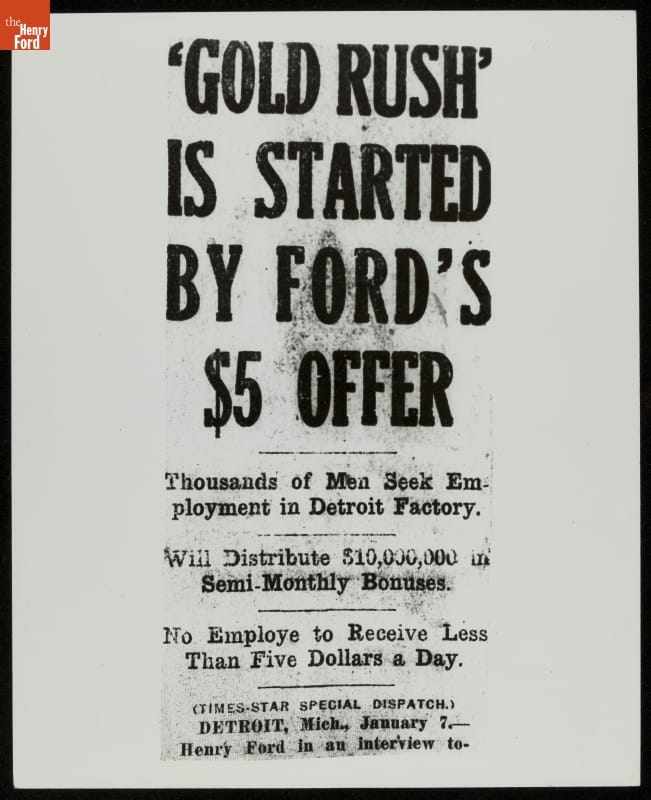
Photographic print - "Newspaper Article, "Gold Rush is Started by Ford's $5 Offer," January 7, 1914" - Ford Motor Company
The automobile industry and Henry Ford’s highly-publicized $5-a-day helped to draw people in great numbers to the Detroit area. However, for African American workers, reality often differed from their hopes and expectations in the north. While many of the automotive manufacturers did hire African Americans, it was almost always for the lowest paying jobs, such as in the janitorial department or the foundry. Ford Motor Company led the automotive industry in its hiring of African American workers by 1919. The company paid African American workers the same rate as their white counterparts and hired for a variety of positions, including skilled labor. Across the board, however, African American workers made less money than their white counterparts, and consequently, had less income for quality housing.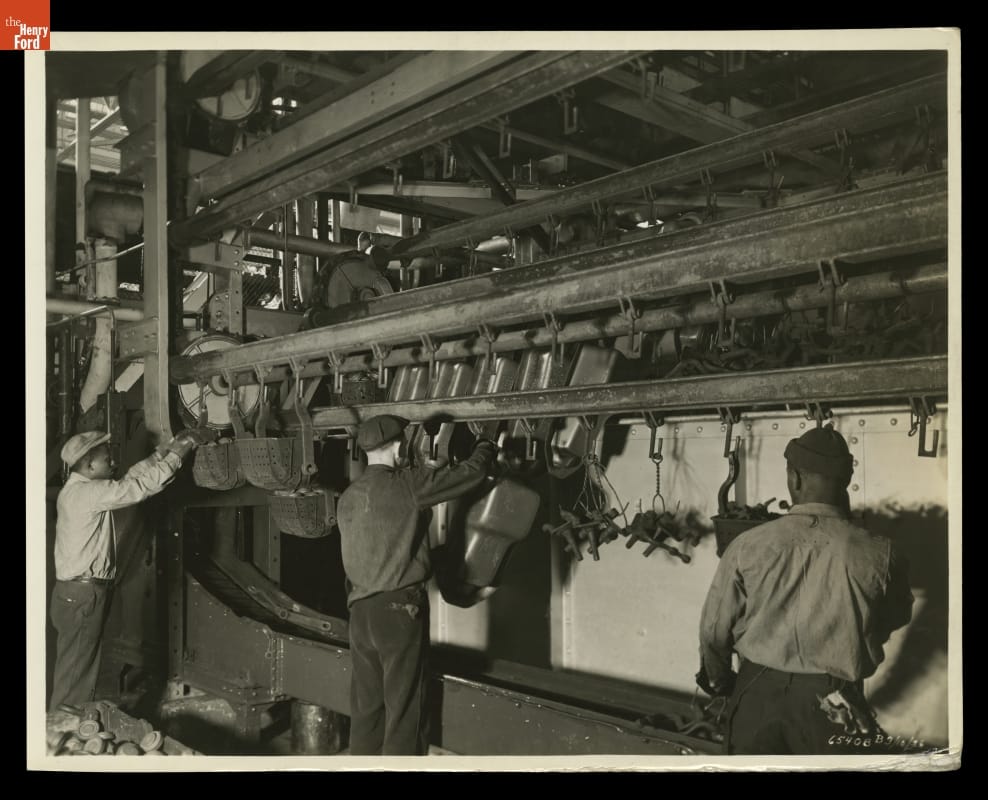
Photographic print - "Pickling Metal Crankcases and Other Parts to Remove Surface Impurities, Ford Rouge Plant, 1936" - Ford Motor Company Photographic Department
Discriminatory real estate practices played a significant role in the housing issues which plagued Detroit. Racially restrictive covenants, which legally ensured the sale of property to only white buyers, became increasingly common in Detroit. Even if a restrictive covenant was not in place, the Detroit Real Estate Board warned area realtors “not to sell to Negroes in a 100 percent white area,” thereby enforcing and perpetuating Detroit’s racial geography. Further, the practice of “redlining,” or the racial categorization of areas by their perceived financial risk in home insurance and mortgage lending, effectively shut out black homebuyers from the market. The practice extended to the lending of new mortgages, but also to home loans, leading to the inability to complete home repairs and, eventually, an abundance of blighted homes in black neighborhoods. In addition, real estate agents erroneously reported to white homeowners that the presence of black families in their neighborhoods would lower their property values. White homeowners, even those without ingrained prejudices against African Americans, certainly did not want their property values to lower, so rallied against any attempt by an African American homebuyer purchasing in their neighborhoods. The infamous story of African American Physician Dr. Ossian Sweet exemplifies the discrimination and mob violence experienced by those who attempted to move into white neighborhoods.
Discrimination in the workplace meant that African Americans, as a whole, made significantly less money than their white counterparts. Redlining practices forced them into racially-segregated neighborhoods and cemented their inability to access loans for mortgages or home repairs. Yet, the promise of the north continued to draw African Americans to Detroit. Without access to capital, increasingly-crowded neighborhoods became increasingly-deteriorated. At each turn, discriminatory systems excluded an entire population from quality housing. From these conditions, Charles H. Lawrence and his family departed Detroit in search of quality housing and a better life. He became the first African American to settle in Inkster, Michigan, and hundreds soon followed.
African Americans Settle in Inkster
The City of Inkster, also located in Wayne County, is approximately fourteen miles from downtown Detroit. Detroit Urban League President John Dancy fielded many housing inquiries from frustrated African American migrants to Detroit in the post-World War I period and beyond. Unable to locate sufficient housing in the City of Detroit, Dancy broadened his search outside the City with hopes that more rural areas would not have the same restrictive covenants and that lesser demand would persuade landowners to sell to African American buyers. In 1920, Dancy succeeded when he found amenable property owners in possession of 140 acres in rural Inkster. Although Inkster’s first African American residents’ settlement in Inkster preceded Dancy’s discovery, the 140 acres of available land enabled and impelled hundreds more African American families to move from Detroit to Inkster, despite the lack of a local government or basic public amenities like streetlights or sewer lines.
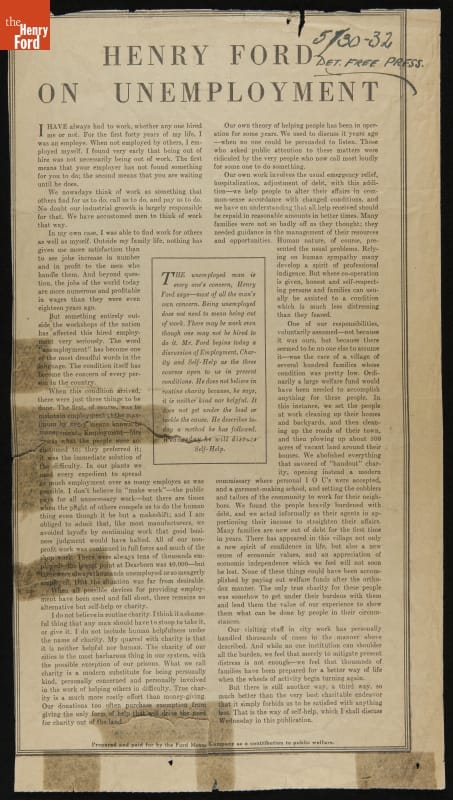
Clipping (Information artifact) - ""Henry Ford on Unemployment," 1932" - Detroit Free Press (Firm)
A Community Becomes a Project
Henry Ford was vocal about his disdain for institutionalized philanthropy. He wrote an entire chapter, entitled “Why Charity?” in an autobiography, and explained, “philanthropy, no matter how noble its motive, does not make for self-reliance…A philanthropy that spends its time and money in helping the world to do more for itself is far better than the sort which merely gives and thus encourages idleness.” Henry Ford’s brand of philanthropy was characterized by helping people help themselves. During the Great Depression, Henry Ford was called upon by the City of Detroit to provide aid because the City’s welfare offices were overwhelmed. Their argument, aside from civic responsibility, was that the City was not receiving taxes from Ford Motor Company (FMC’s factories were located outside Detroit) yet as many as “36 percent of the families receiving care from the City of Detroit were former Ford employees” in 1931. The public goodwill that Ford’s $5 a day policy brought was quickly dissipating. In 1931, Ford agreed to two philanthropic ventures; he provided a low-interest, short-term $5 million loan to the City of Detroit and essentially took the then-Village of Inkster under the Ford Motor Company’s auspices.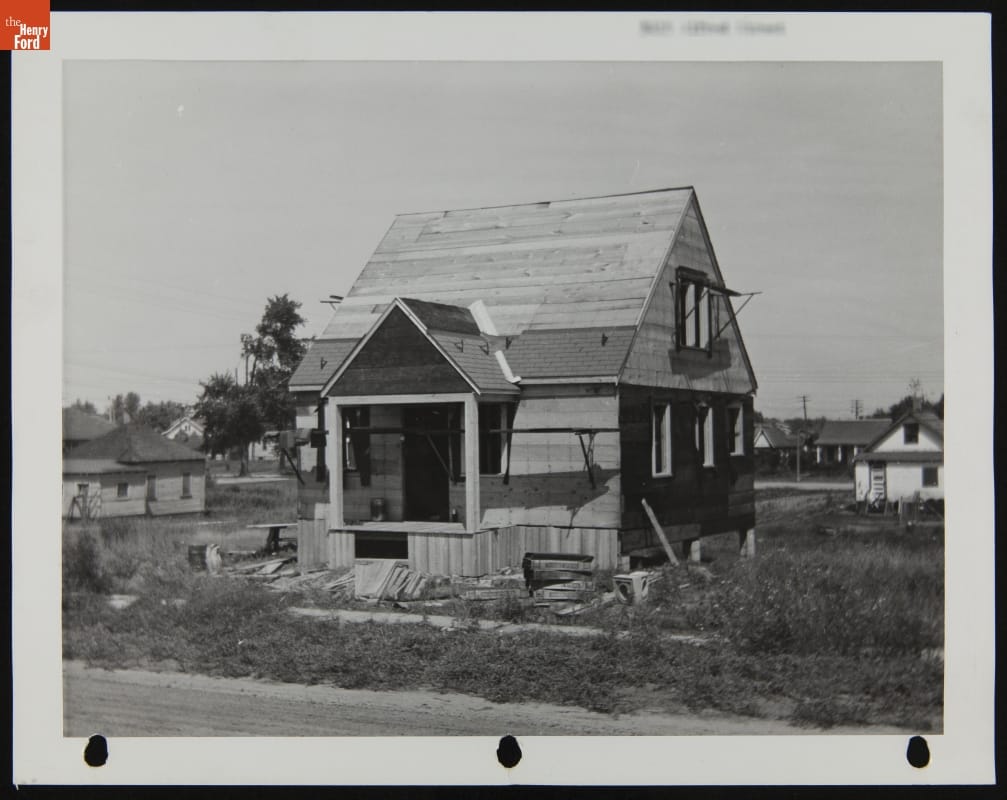
Photographic print - "Ford Motor Company Employee Home Improvement Project, Inkster, Michigan, 1930-1944" - Ford Motor Company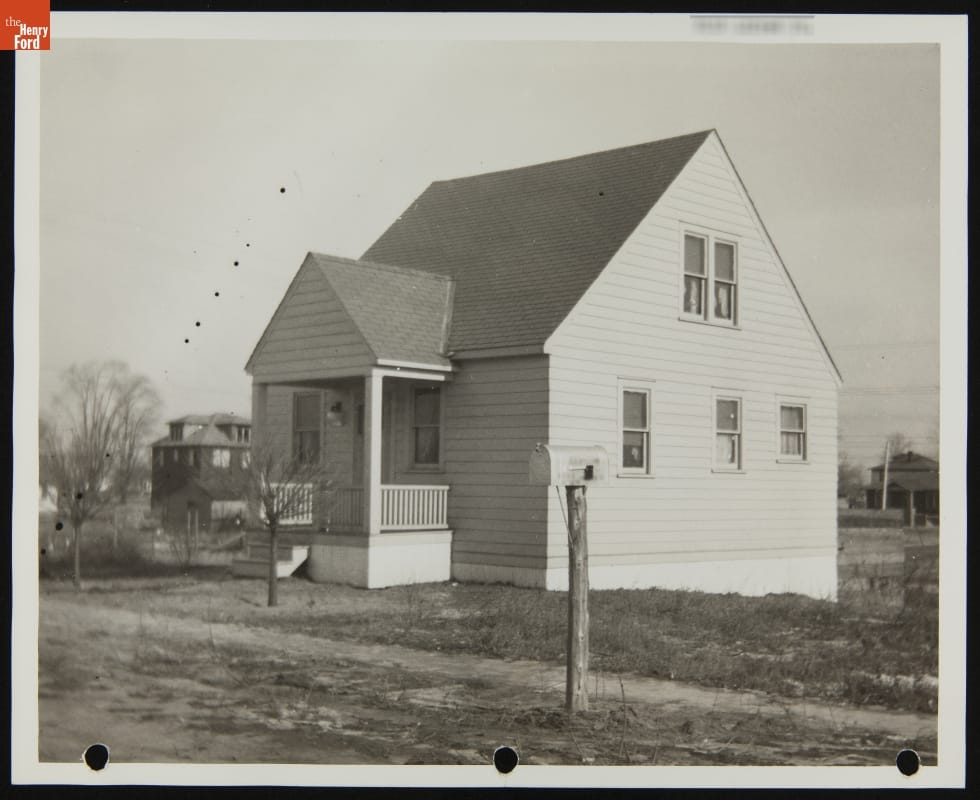
Photographic print - "Ford Motor Company Employee Home Improvement Project, Inkster, Michigan, 1930-1944" - Ford Motor Company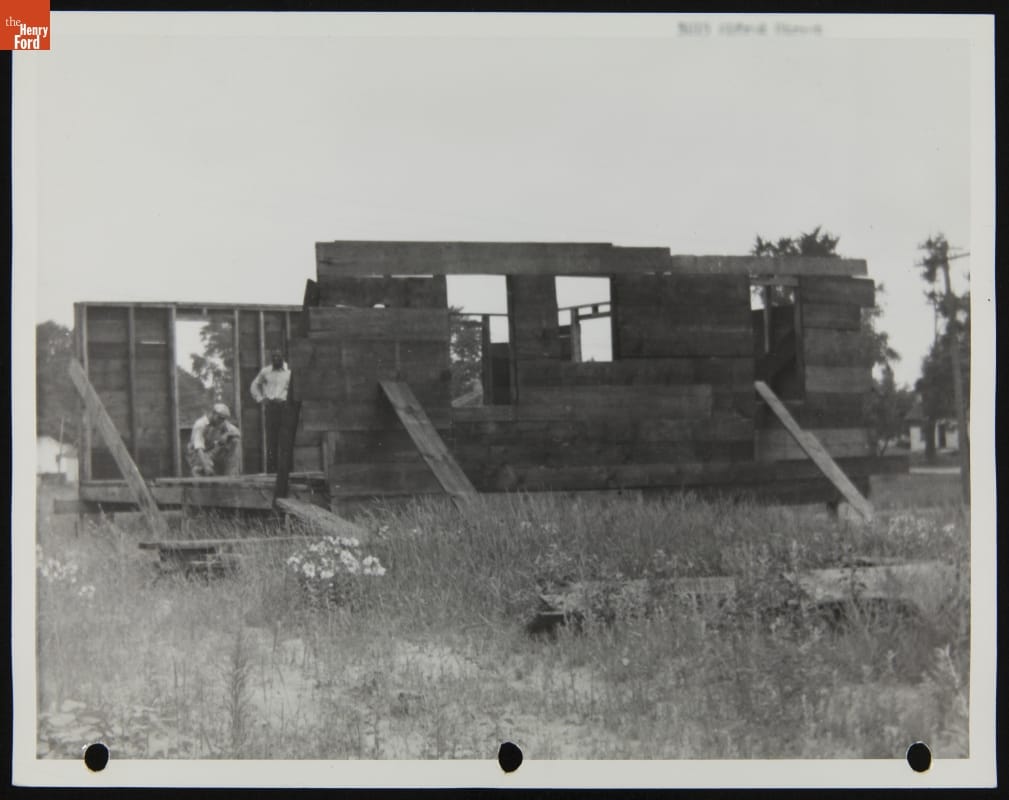
Photographic print - "Ford Motor Company Employee Home Improvement Project, Inkster, Michigan, 1930-1944" - Ford Motor Company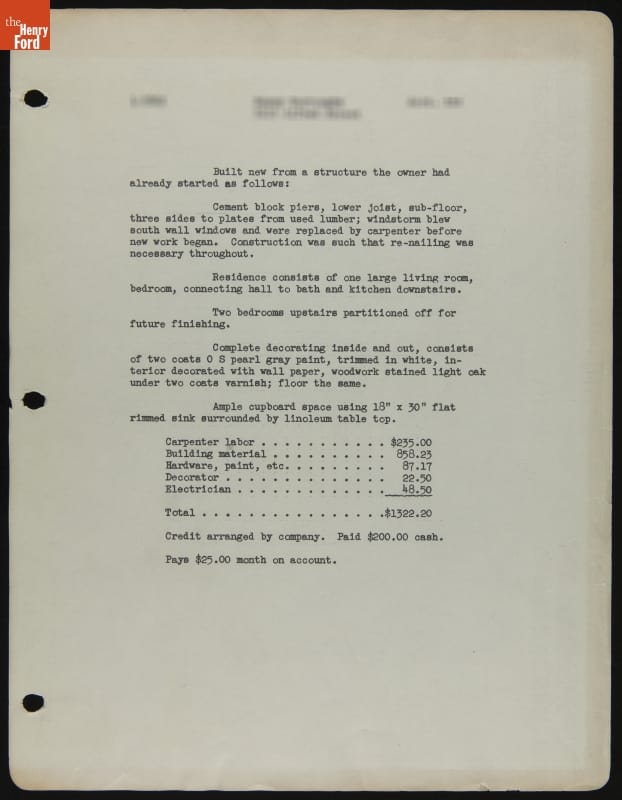
Report - "Ford Motor Company Employee Home Improvement Project, Inkster, Michigan, 1930-1944" - Ford Motor Company
By 1931, a few years into the Great Depression’s hardships, the residents of Inkster were struggling. Unemployment and debt were high, public services had been cut, and many residences remained partially-completed, as the Great Depression halted progress in the young village. Controversially, Henry Ford placed FMC’s Sociological Department in charge of what became known as the Inkster Project. The Sociological Department was created in 1914 in order to manage the diverse workforce and ensure employee adherence to the company’s strict standards, which were paternalistic in nature and often crossed the home life-work life boundary. In Inkster, the Sociological Department immediately began implementing programs to comprehensively rehabilitate the village. A commissary, which sold high-quality, low-cost food and essential home goods, was established. Coal was distributed to those who needed it to heat their homes. Debtors were paid off, and a medical clinic and school were constructed. Homes deemed insufficient were rehabilitated. The inability to pay for these services was irrelevant; a type of “I.O.U,” repayable through Ford-provided work and wages, was enough to access all life’s necessities.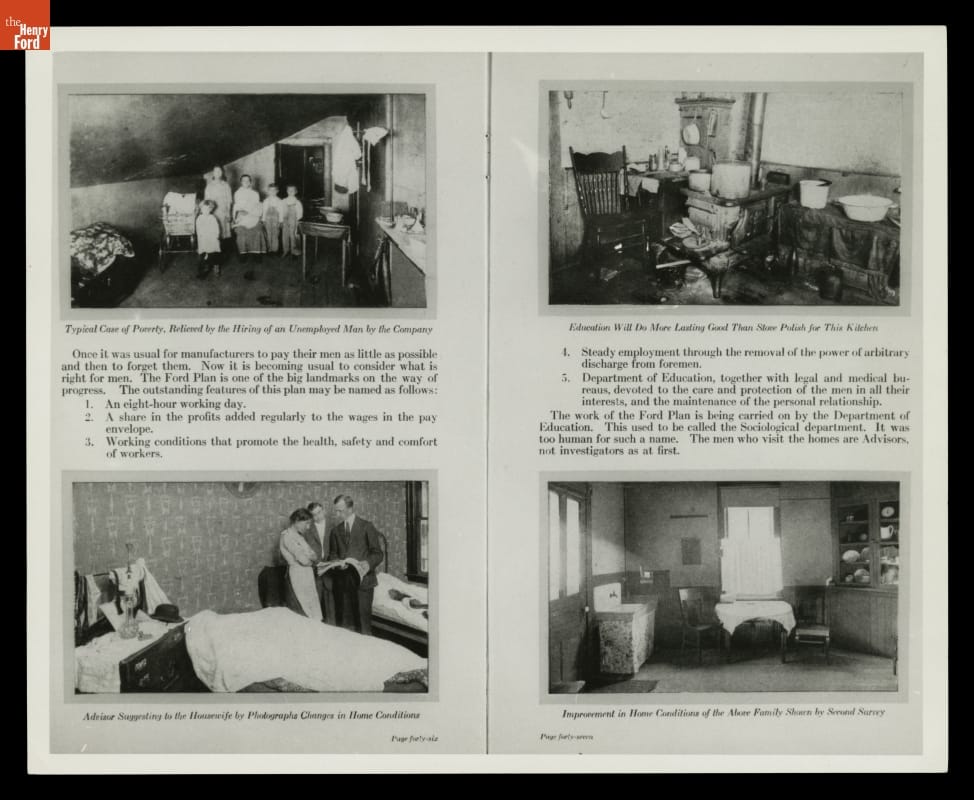
Photographic print - "Checking on Ford Employees Home Conditions, Views from "Factory Facts From Ford," 1917"
The Legacy of the Inkster Project
Although the Inkster Project was generally highly-regarded at the time, the FMC Sociological Department’s role was often overreaching. When agreeing to Ford’s aid, an Inkster resident was also agreeing to running their household as preferred by Henry Ford. Although his funds undoubtedly helped Inkster during the Great Depression, Ford’s motives were not entirely altruistic. Besides the much-needed public relations boost he received from the Inkster Project, he also was able to assert his influence and ideals on a community that largely had no choice but to accept his aid -- with all strings attached.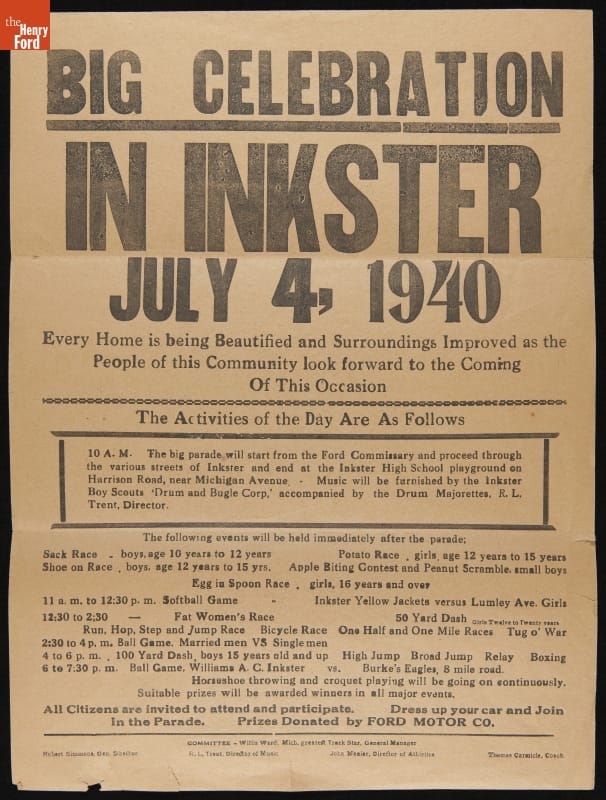
Broadside (Notice) - "Big Celebration in Inkster," July 4, 1940"
The Inkster Project’s legacy is complicated; many historians criticize Henry Ford’s paternalistic nature and the perhaps forceful imposition of his will onto the desperate, but others, including former residents of Inkster, praise Henry Ford for his aid. In her reminiscences, Georgia Ruth McKay explains that Inkster became a “jungle village changed into a city” during this period and that, “without his [Henry Ford’s] help, many would not have survived.” The Inkster Project was slowly phased out, but continued to operate in Inkster until 1941 when all programs were withdrawn.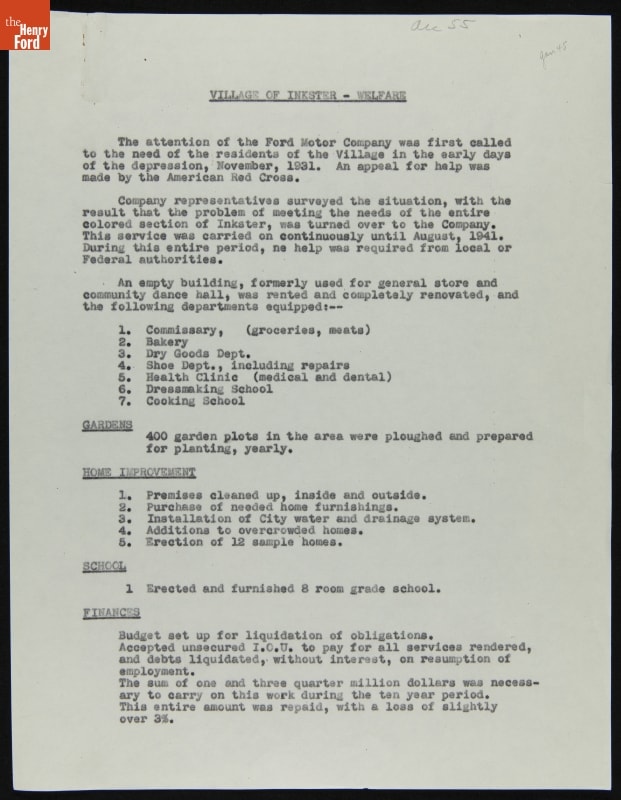
Progress report - "Village of Inkster Welfare Report, 1931-1941" - Ford Motor Company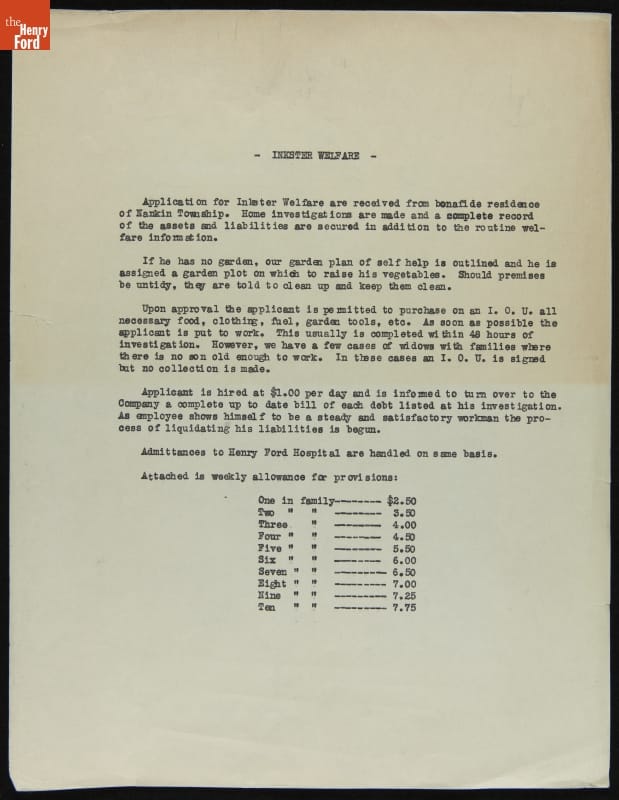
Report - "Village of Inkster Welfare Provision Report, circa 1936" - Ford Motor Company
Katherine White is Associate Curator, Digital Content, at The Henry Ford. In writing this piece, she appreciated the research and writings of Beth Tompkins Bates’ “The Making of Black Detroit in the Age of Henry Ford”, Thomas J. Sugrue’s “The Origins of the Urban Crisis; Race and Inequality in Postwar Detroit,”, and Howard O’Dell Lindsey’s dissertation, “Fields to Fords, Feds to Franchise: African American Empowerment in Inkster, Michigan.”
20th century, Michigan, labor relations, home life, Henry Ford, Ford workers, Ford Motor Company, Detroit, by Katherine White, African American history
Another Thought on NAIAS 2017

I’ve already shared some thoughts on the 2017 North American International Auto Show, but one important new car wasn’t yet revealed during my visit last week. Of course, I’m talking about the LEGO Batmobile from Chevy.
My tastes in bat-transportation run more traditional, but Chevy has something going for it here. The LEGO Batmobile’s 20,000-horsepower rating makes it eight times as powerful as the Goldenrod land speed racer. Likewise, the V-100 engine’s 60.2-litre displacement is more than eight and a half times what it took for the Mark IV to win at Le Mans fifty years ago. The LEGO Batmobile’s styling achieves that rare combination of aerodynamic and exquisite, certain to turn heads on every street corner. Be sure to order the optional bat hood ornament – superior to anything by Lalique. (Besides, everybody knows that bats eat dragonflies.)
Continue Reading21st century, 2010s, toys and games, NAIAS, Michigan, LEGO, Detroit, cars, car shows, by Matt Anderson
Mrs. Cohen: A Fashion Entrepreneur

Life is often a juggling act of work, play and family. While current-day clothiers experience the trials and tribulations of being small-town entrepreneurs in the big business of fashion, more than 100 years ago many women were facing similar circumstances, leaning on their sense of style to furnish a living.
In the late 1800s, Elizabeth Cohen had run a millinery store next to her husband’s dry goods store in Detroit. When he died and left her alone with a young family, she consolidated the shops under one roof. Living above the store, she was able to run a business and earn a living while staying near her children.
Cohen leveraged middle-class consumers’ growing fascination with fashion, using mass-produced components to create hats in the latest styles and to the individual tastes of customers. To attract business, resourceful store owners like Mrs. Cohen displayed goods in storefront windows and might have advertised through trade cards or by placing advertisements in newspapers, magazines or city directories.
“While Mrs. Cohen was more likely following fashion than creating it, it did take creativity and design skill,” Jeanine Head Miller, curator of domestic life at The Henry Ford, said of Cohen’s millinery prowess. “She was a small maker connecting with local customers in her community — a 19th-century version of Etsy, perhaps, but without the online reach.”
And she certainly gained independence and the satisfaction of supporting her family while selling the hats she created from the factory-produced components she acquired. “People can appreciate the widowed Elizabeth Cohen’s balancing act,” added Miller, “successfully caring for her children while earning a living during an era when fewer opportunities were available to women.”
Jennifer LaForce is a writer for The Henry Ford Magazine. This story originally appeared in the June-December 2016 issue.
19th century, women's history, The Henry Ford Magazine, shopping, Michigan, making, hats, Greenfield Village buildings, Greenfield Village, fashion, entrepreneurship, Detroit, design, Cohen Millinery, by Jennifer LaForce
“A Very Practical and Purposeful Program”

Last summer, our 2016 Edsel B. Ford Design History Fellow, Meredith Pollock, investigated materials in our collection related to Edsel and Eleanor Ford’s philanthropy, including a thread concerning the NAACP. The National Association for the Advancement of Colored People was founded February 12, 1909, on the centennial of Abraham Lincoln’s birth. The goal at the time, as the NAACP’s website notes, was to “secure for all people the rights guaranteed in the 13th, 14th, and 15th Amendments to the United States Constitution, which promised an end to slavery, the equal protection of the law and universal adult male suffrage, respectively.”
Judge Ira W. Jayne of the third judicial circuit of Michigan reached out to Eleanor Ford for a donation to the Detroit branch of the NAACP in 1922. In a letter we’ve just digitized, Jayne calls the organization “the most intelligent and wholesome effort for and in behalf of the betterment of race conditions in the country today” and notes that his “knowledge of [Eleanor’s] interest in fair play for the under man has prompted this letter.” Jayne did succeed in his goal—a reply two weeks later from Edsel Ford calls the NAACP’s goals “commendable” and includes a donation for $100.
Visit our Digital Collections to view more artifacts related to the NAACP.
Ellice Engdahl is Digital Collections & Content Manager at The Henry Ford.
digital collections, Michigan, Detroit, African American history, Edsel Ford, philanthropy, by Ellice Engdahl
Report from the 2017 North American International Auto Show

Chrysler’s Portal concept car. The company that invented the minivan now reimagines it.
It’s that time of year again, when the North American International Auto Show (NAIAS) brings the world’s largest automobile manufacturers to Detroit to tempt us with their upcoming models – and tease us with a few dreamy concepts. As usual, the show does not disappoint. Autonomous concept cars, compact crossovers and alternative fuels are all prominent at this year’s event. Ford’s 2016 GT Le Mans winner, still covered in dust and glory.
Ford’s 2016 GT Le Mans winner, still covered in dust and glory.
Ford is rightfully proud of its big win in the GTE-Pro class at the 2016 Le Mans 24-hour race. Not surprisingly, the #68 GT piloted to victory by Sebastien Bourdais, Joey Hand and Dirk Muller is front and center at the company’s booth. What is pleasantly surprising, though, is that the Blue Oval resisted the urge to clean up the car and instead is displaying it in all of its battle-scarred glory. The GT wears that dirt and grime like a badge of honor.
Ford’s autonomous Fusion Hybrid. The company promises a fully autonomous car for public use in 2021.
Ford has made headlines recently with its plan to reposition itself as a mobility company rather than a carmaker. Head to the back of the firm’s NAIAS space and you’ll see that it’s more than mere talk. There’s a Go Bike from Ford’s bicycle sharing program in San Francisco, and a mention of the Chariot ride-sharing service the company purchased there in 2016. The real highlight for me, though, was the autonomous Fusion Hybrid. Apart from a pair of LIDAR units mounted above the side-view mirrors, most of the car’s sensors are hidden in what could pass for a luggage rack. Ford promises a fully autonomous vehicle in ride-sharing service in 2021. It seems the car won’t look all that different from anything else on the road. (While those LIDAR units are fairly discreet, I’m holding out for the inevitable autonomous car with an infrared scanner.)
I always love the cutaways, like this V-6 from the all-wheel drive Cadillac CT6. Note the black driveshaft, running alongside the gearbox and bell housing, which sends power to the front wheels.
Chevrolet Bolt, the 2017 North American Car of the Year.
General Motors has its own reason to crow. The Chevrolet Bolt takes honors as 2017’s North American Car of the Year. Chevy promises 90 miles of range with a 30-minute charge, certainly impressive in the EV category. And the Bolt’s 0-60 m.p.h. time of 6.5 seconds may not be Tesla-type ludicrous, but it’s a full second faster than many of its gas-powered subcompact competitors. And speaking of unconventional fuels, the General’s GMC Terrain crossover gets an optional diesel engine for 2018. GM hasn’t always had the best of luck with diesels, but the fuel efficient 1.6-liter engine could make Terrain buyers happy at the pump.
Gustaf, the Volvo Spokesmoose. He’s there to promote the Swedish carmaker’s large animal detection system – and to provide a fun photo opportunity.
The 2018 Toyota Camry gets an aggressive look to match its aggressive sales.
Toyota always mounts an impressive display at NAIAS, and this year is no exception. The company’s big surprise is a robust facelift to its perennially best-selling Camry. The 2018 model gets an angular, aggressive front end wholly unexpected on a sedan that’s practically synonymous with, well, “practical.” They say you should never mess with success, but you don’t become the world’s largest automaker by taking blind risks. I’m sure the focus groups loved the redesign. Besides, it’ll look great at Daytona.
Volkswagen’s I.D. Buzz autonomous van. Think how many more mysteries Scooby and the gang could solve if Fred didn’t have to worry about driving.
Thanks to its diesel shenanigans, Volkswagen had a rough year, but you wouldn’t know it looking at the German manufacturer’s NAIAS booth. They’ve brought what might be the most eye-catching concept vehicle at Cobo Center. The I.D. Buzz is a cheery homage to the classic Microbus, but the hippies have gone high-tech. The Buzz is all-electric – and intended to be fully autonomous. As envisioned, the van gives owners the best of both worlds with a standard manual mode that can be switched over to automatic whenever the driver needs a break.
Presumably, the gas tank on this one is empty while it’s in Cobo Center – just like it was when Alexander Rossi coasted across the finish line in first place at last year’s Indianapolis 500.
Another notable race car, the 2006 Rust-eze Special. Sure to be a hit with the toddler set.
While I could have spent the whole day wandering through the main hall, I’m glad I saved some time for the lower level. From January 8-12, the space hosted “AutoMobili-D,” a dedicated exhibition focused on autonomous vehicle research, urban mobility, and a number of techy startup companies. Of particular note was the booth devoted to the University of Michigan’s Mcity autonomous vehicle test facility. That Ann Arbor track, together with the American Center for Mobility at Willow Run, enables Michigan to hold its own against the tech titans of Silicon Valley, who threaten to take away the Great Lake State’s mantle of automobile R&D leadership.
The Henry Ford’s 2010 Edison2, on view in Campus Martius.
If your visit to NAIAS takes you through Campus Martius, you might take a moment to peek in the lobby of the One Campus Martius building. There you’ll find our own Edison2 concept car, winner of the 2010 Progressive Automotive X Prize. The gasoline-powered vehicle, which weighs all of 830 pounds, got more than 100 miles per gallon during the competition. What with all of the folks from around the globe in Detroit this week, we thought we might tempt them to visit us in Dearborn. What better break from the cars of today and tomorrow than a look at the innovative automobiles of yesterday?
Matt Anderson is Curator of Transportation at The Henry Ford.
events, 21st century, 2010s, technology, NAIAS, Michigan, Detroit, cars, car shows, by Matt Anderson, autonomous technology
Join the Industrial Revolution... Workshop
The Henry Ford proudly announces that the National Endowment for the Humanities has awarded our institution a grant to again offer the Landmarks of American History and Culture Workshop “America’s Industrial Revolution at The Henry Ford” for K-12 teachers. The workshops will be held July 9-14, 2017 and July 16-21, 2017.
Participating teachers will explore the varied ways that Americans experienced social change between 1760s and the 1920s through lecture/discussions by noted scholars and by visiting select sites at The Henry Ford, Greenfield Village and Henry Ford Museum, including Thomas Edison’s Menlo Park Laboratory, working farms, historic transportation, and Ford Motor Company’s Rouge industrial complex. In addition, participants will explore archival sources in the Benson Ford Research Center and dedicate time to lesson plan development with colleagues.
“Learning by doing” - Scything, pre-Industrial Revolution.
Next year will be the eighth time The Henry Ford has hosted the America’s Industrial Revolution workshop. This deep learning experience has touched almost 500 teachers in the past 11 years – we estimate over 700,000 students have been impacted!
This year we are making some exciting tweaks that will make the week even more fruitful and more fun.
The biggest change is that we are adding a bus tour of Industrial Revolution-era Detroit. Participating teachers come from all over the country (and sometimes abroad, if they are teaching in military schools, etc.) and they just can’t miss our neighboring city which had such a pivotal role in America’s industrial story. On Monday evening, the second night of the workshop, teachers will take a tour bus to explore a few key areas of Detroit. We will visit Hamtramck, Highland Park, the Ford Piquette Avenue Plant and Corktown, allowing us to move through Detroit history from the era of a frontier surrounded by farmland, to a growing city fueled by industrial production that came to spawn the king of American manufacturing, the automobile industry. 
Henry Ford designed the Model T in a secret room at the Piquette Plant.
We have found that participating teachers are often history junkies (just like ourselves) hungry for more learning. So, during our daily site visits to Greenfield Village we will use our knowledgeable master presenters as guides. We invite you to try to stump them with the great questions we know teachers always have.
Speaking of historical learning, we have updated the workshop reading list to include some more recent and more diverse pieces of scholarship on the Industrial Revolution. I particularly enjoyed Steel Drivin’ Man: John Henry, the Untold Story of an American Legend by Scott Reynolds Nelson. It tells about a historian’s journey to uncover the real story behind the folk song about John Henry, investigating if there was truly an African-American convict working on the railroad who died in a contest with a steam drill.
We want to encourage more useful lesson-planning time, too. So we have allocated time during the day to spend with colleagues of similar grades/subjects to plan lessons and to visit the Benson Ford Research Center to make use of our primary sources. We will also encourage teachers to use those primary sources virtually through our online collections. Teachers will see our rich collections in use by the scholars each morning, too.
Read and touch primary sources at the Benson Ford Research Center.
And it’s not just for social studies teachers. The workshop will be useful in many types of K-12 classrooms. Obviously if you teach the period of the Industrial Revolution, or eras following it, this background is indispensable for you. Science, technology and engineering teachers will discover concrete, society-changing examples of the concepts they teach. English Language Arts teachers will experience a taste of the eras that produced literature like Little House on the Prairie, The Jungle, Mark Twain, slave narratives, and (from across the pond) Dickens’ many works. Art teachers may find themselves inspired by the beauty of the machinery, as did Diego Rivera and Charles Sheeler at the Ford Rouge Factory.

Rivera was inspired by the Ford Rouge Factory for his “Detroit Industry” fresco cycle at the Detroit Institute of Arts. THF116582
Sounds fun, doesn’t it? To learn more about the workshop, and to apply, please visit thehenryford.org/neh. Applications are due March 1.
Christian W. Overland is Executive Vice President of The Henry Ford and Project Director, America’s Industrial Revolution at The Henry Ford.
Catherine Tuczek is Curator of School and Public Learning at The Henry Ford.
by Catherine Tuczek, by Christian W. Øverland, events, Michigan, Detroit, educational resources, education, teachers and teaching
Looking Back to Move Forward

If you’ve walked through “With Liberty and Justice for All” in Henry Ford Museum, you’re familiar with the long and complicated history of social transformation, including civil rights and race relations, in America. Some artifacts, like the Rosa Parks Bus, are primary sources in this story, but we also hold collections that offer a more oblique take, such as about 100 photo negatives we’ve just digitized relating to five days of civil unrest in Detroit in July 1967.
The images come from Detroit Edison, which was charged with the very normal work of restoring electricity under very abnormal conditions. While the photos primarily document the power company’s work in the wake of the unrest, the events of the preceding days and their aftermath are omnipresent, as you can see in this image. We undertook this digitization project as part of our participation in “Detroit 67: Looking Back to Move Forward,” “a multi-year community engagement project of the Detroit Historical Society that brings together diverse voices and communities around the effects of an historic crisis to find their place in the present and inspire the future.”
During 2017, we shared more collections-based stories related to the complex roots of, and reactions to, Detroit 67, in keeping with our mission to inspire people to help shape a better future. For now, visit our Digital Collections to browse all of the July 1967 Detroit Edison images.
Additional Readings:
- The Ingersoll-Rand Diesel-Electric Locomotive: Boxy but Significant
- Pioneers of Electricity
- #InnovationNation: Power & Energy
- Power by the Quarter
1960s, 20th century, power, Michigan, electricity, digital collections, Detroit, by Ellice Engdahl, African American history
Tracing Innovation, Resourcefulness, and Ingenuity in... Beverages

From November 20, 2016, through March 5, 2017, our colleagues at the Detroit Institute of Arts (DIA) are presenting an exhibition called Bitter|Sweet: Coffee, Tea & Chocolate. The exhibit will trace the impact of these beverages in Europe, beginning in the late 16th century. One set from The Henry Ford’s collections—this late 18th century tea service—will be on loan to the DIA, helping visitors understand what a formal tea setting would have looked like.
As we learned more about the exhibition, we saw additional parallels between the DIA’s goals and our own collections’ artifacts and themes, and ways our collections can extend the messages of the exhibit. The DIA will help explain how these new tastes spawned a design revolution and entirely new industries devoted to creating specialized tableware; our Made in America exhibit in Henry Ford Museum covers how British innovations in power and production machinery made way for the increasingly precise manufacture of porcelain and other mass-produced goods to support these needs, beginning the Industrial Revolution. Bitter|Sweet will focus on Europe, but The Henry Ford’s collections explore how the craze for these new beverages spread to America—including the tale of early American artisan and entrepreneur Paul Revere.
The exhibit will be interactive, allowing guests to explore via all five of their senses, which is similar in approach to Greenfield Village—for instance, being able to experience the sights, sounds, and smells of historic chocolate-making in our Holiday Nights in Greenfield Village program. And last, coffee, tea, and chocolate all remain popular today, allowing us to bring the past forward and show how these historic drinks fit into life in modern America.
Over the course of the exhibit, we’ll be adding links to this post that explore some of these themes in our collections. We hope these will provide a deeper understanding of the impact these three once-exotic drinks have had, from the earliest days of our country’s history right on through to the takeout coffee in your hand.
Drinking Chocolate, American-Style
Chocolate beverages in the collection
Coffee in the collection
Tea in the collection
Paul Revere and The Henry Ford's Tie to Tea
Ellice Engdahl is Digital Collections & Content Manager at The Henry Ford.
Michigan, Detroit, food, Detroit Institute of Arts, by Ellice Engdahl, beverages
Henry Ford and the Detroit Symphony Orchestra
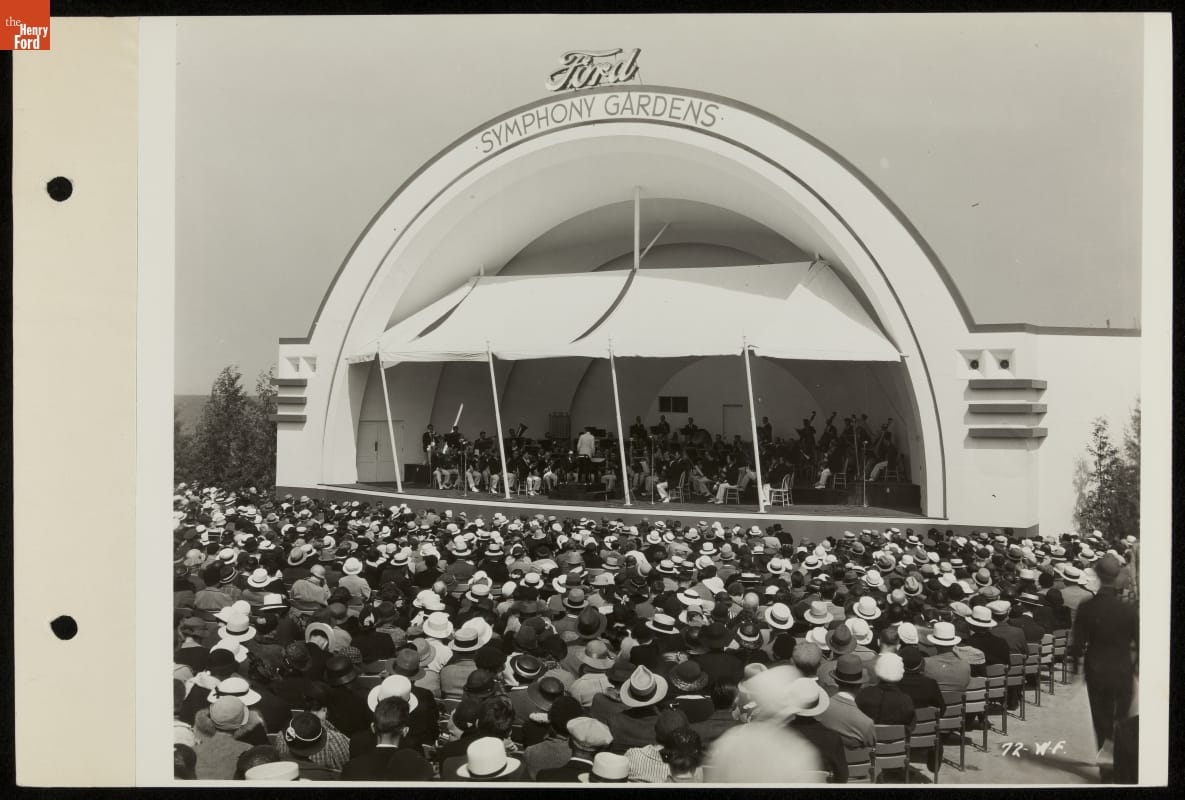
Concert in the Ford Symphony Gardens, Century of Progress International Exposition, Chicago, Illinois, 1934. THF212561
For the past 24 years the Detroit Symphony Orchestra and The Henry Ford have teamed up for Salute to America, our annual concert and fireworks celebration in Greenfield Village. But the affiliation between the DSO and our organization goes back much farther than that.

Preparing for a Performance in Ford Symphony Gardens, Century of Progress International Exposition, Chicago, Illinois, 1934. THF212547
The connection dates back to the 1934 Chicago World's Fair, A Century of Progress International Exposition. Ford Motor Company’s exhibits were housed in the famous Rotunda building and also included the Magic Skyway and the Ford Symphony Gardens. The large amphitheater of the Symphony Gardens hosted several musical and stage acts, including the DSO, who Ford sponsored for 150 concerts over the course of the year. The symphonic notes proved so popular that Henry and Edsel Ford decided to launch a radio program featuring selections from symphonies and operas - the Ford Sunday Evening Hour. The weekly program played to over 10,000,000 listeners each broadcast over the CBS network (the same network that now presents The Henry Ford's Innovation Nation). Musical pieces were played by DSO musicians under the name Ford Symphony Orchestra, a 75-piece ensemble, and were conducted by Victor Kolar, the DSO’s associate director, for the first few years of the show. Pieces ranged from symphony classics including works by Handel, Strauss, Liszt, Wagner, Handel, Puccini, Bizet, and Tchaikovsky (including, of course, the 1812 Overture), to some of Henry Ford’s favorite traditional and folk songs like Turkey in the Straw and Annie Laurie, and even included popular tunes such as Night and Day by Cole Porter.
Each broadcast featured guest stars, soloists, and singers such as Jascha Heifetz, Grisha Goluboff, Gladys Swarthout, Grete Stükgold, and José Iturbi. The broadcast performances were open to the public for free, first at Orchestra Hall from 1934-1936, and then at the Masonic Temple 1936-1942. The show ran from 1934-1942, September-May with 1,300,000 live attendees and countless radio listeners tuning in.
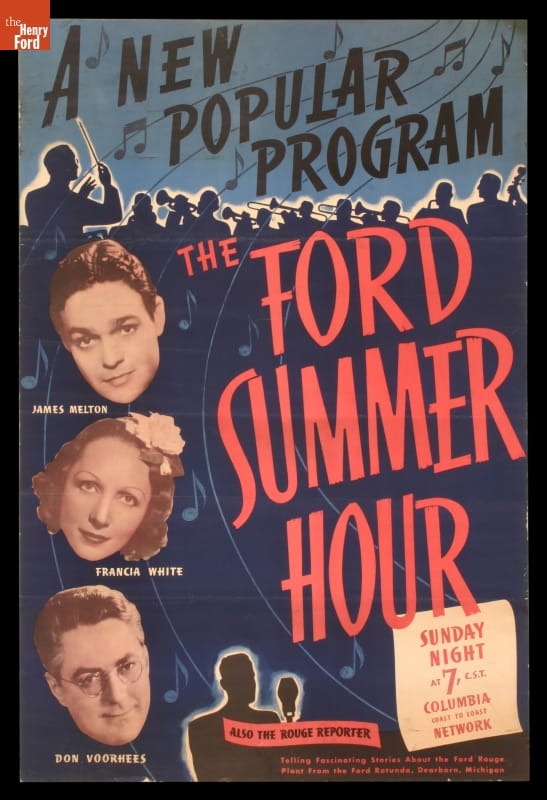
Advertising Poster, The Ford Summer Hour, 1939. THF111542
Salute to America is our summer music tradition, and listeners in 1939 must have wanted some summer-themed music as well because Henry and Edsel started the Ford Summer Hour that year. Like the winter program, it was broadcast each Sunday evening on CBS, from May to September and featured a smaller 32-piece orchestra, again mostly made up of DSO musicians. Guest stars and conductors appeared, such as Don Voorhees, James Melton, and Jessica Dragonette.
The show included music from Ford employee bands like the River Rouge Ramblers, Champion Pipe Band, and the Dixie Eight. This was a program of lighter music, popular songs, and tunes from musical comedies and operettas. Apparently not everyone appreciated the lighter fare; a letter from a concerned listener stated:
“...as the strains of the trivial program of Ford Summer Show float into my room, I am moved to contrast them with the fine programs of your winter series, and to wonder why the myth persists that in hot weather the human mentality is unequal to the strain of listening to good music. Pardon me while I switch my radio to station WQXR which has fine music the year round.”
Strong words from the listening public, though apparently not the majority as the summer program rivaled the winter program with about 9,000,000 listeners per broadcast. The Ford Summer Hour, broadcast from the Ford Rotunda, only ran three seasons, but played a wide range of music for listeners such as Heigh Ho from Snow White, Dodging a Divorcee, selections from Carmen, Oh Dear, What Can the Matter Be, and One Fine Day from Madame Butterfly.
Both programs ceased by 1942 with the opening of World War II. Henry Ford II tried to bring back the Ford Sunday Evening Hour in 1945, broadcasting the same type of music by DSO musicians, but times and tastes had changed and the program was discounted after the first season.
Kathy Makas is a Benson Ford Research Center Reference Archivist at The Henry Ford. To learn more about the Ford Sunday Evening Hour or Ford Summer Hour, visit the Benson Ford Research Center or email your questions to us here.
Greenfield Village, events, Salute to America, by Kathy Makas, Ford Motor Company, Edsel Ford, Ford family, radio, world's fairs, Michigan, Henry Ford, music, Detroit
Homegrown Wearables

DESIGNERS DISILLUSIONED WITH FAST FASHION LOOK TO CREATE A GRASSROOTS GARMENT INDUSTRY ONE CITY AND ONE HANDMADE SHIRT AT A TIME
Laura Lee Laroux is full of confidence, even though some peers say she shouldn’t be.
Laroux, 36, moved to Bozeman, Montana, with seven sewing machines and 12 rolls of fabric in a U-Haul earlier this year, intent on making the rugged town at the northern foot of the Gallatin Range the new headquarters of her clothing line. She calls it RevivALL because she upcycles old materials into new garments, such as ruffled dresses fashioned from men’s shirts and hip bags revived from leather scraps bought from a recreational vehicle manufacturer.
Laroux had been overly busy and underearning in her previous home of Eugene, Oregon, running a clothing boutique, co-producing a local fashion week and, in the snatches of remaining time, working on developing RevivALL. But then, like so many bold Americans, from the pioneers to Kerouac on down, she concluded that her destiny, her chance to leave the old muddle behind and pursue her dream full time, lay elsewhere. “I just got some kind of rumbling inside me that said I have to leave Eugene,” said Laroux.
But Bozeman, population 37,000, isn’t New York or Los Angeles, teeming with seamstresses, fashion buyers and media. Why does she think she can make it there?
The same could be asked of legions of other upstart fashion designers setting up shop in locales such as Lawrence, Kansas; Nashville; and Detroit, none fashion capitals likely to be featured on Project Runway.
Something is afoot.
The odds of upstarts breaking profitably into the $2.5 trillion international fashion business remain long, but American entrepreneurs like Laroux have been newly emboldened to try by a confluence of cultural and economic forces. These include an appetite among some activist consumers to opt out of the fast-fashion system; Web stores like Etsy that connect small makers to buyers everywhere; low costs in postindustrial American cities; the decline of New York’s garment district; and fledgling pockets of support for apparel startups by government and not-for-profit groups. The result of all this has been the growth — sometimes halting, occasionally stunted, but often encouraging — of grassroots garment industries across the American landscape.
“Not all designers have to come to New York,” said Lisa Arbetter, editor of the influential fashion magazine StyleWatch, which has a per-issue circulation of 825,000. “Every line doesn’t have to be sold in Saks.”
A LITTLE IS ENOUGH
It might seem counterintuitive, but the fact that 97 percent of the clothing sold in the United States is now made overseas, up from 50 percent in 1990 and 10 percent in the 1960s, has created opportunity for American makers. While Zara, H&M, Gap and Fast Retailing, the parent of Uniqlo, have annual sales of more than $74 billion combined, some of the fashion-forward want to wear clothes that a million other people aren’t also slithering into.
What’s especially sweet about the kind of apparel businesses those like Laroux are starting is that a little success can be enough. Their ambition is not to become the next Betsey Johnson or Yves St. Laurent, but merely to gain the satisfaction of earning enough money selling dresses made from shower curtains, cruelty-free handbags or bespoke belt buckles to quit their boring day jobs.
“I’m close to making a living on my own stuff,” said Leslie Kuluva, who has seen sales of her line of LFK T-shirts printed in Lawrence, Kansas, rise every year since 2006. Kuluva says when she started, “I used to print them on my living room table and lay them out on the couch to dry, and cats would be walking all over them.”
Now, the “stuff” she creates in her professional print shop on East 8th Street in the college town includes men’s ties she buys at thrift stores and upcycles by printing clever designs on them, along with baby onesies and adult shirts she buys wholesale and unprinted from American Apparel, adds LFK logos to and sells at a profit of roughly $10 a garment. The line is carried at downtown shops such as Wonder Fair and Ten Thousand Villages eager to support local makers.
MORE THAN A HOBBY
Of course, having one artist or even a dozen eke out a living printing shirts one by one is not on its own enough to jump-start the economy of a town or change fashion as we know it. The challenges in taking a step up from that by launching a relatively small national apparel brand are formidable, as would-be entrepreneur Lisa Flannery learned over the past few years. A veteran of two decades of toil in various roles at big brands in the Manhattan fashion business, Flannery attempted to start her own surfwear line.
“You need serious capital for development and production; unlimited amounts of time for sourcing, designing and fitting,” Flannery shared in a long and deeply detailed gush during a short break from her current job as a technical design manager at a national clothing brand. “And a partner or really good friends and family to help you with the sales, marketing and PR, legalities and accounting, etc., because you need to handle design and production, which are really jobs for multiple people — if you can manage to handle that, then you confront massive minimums, which is why you need all of that capital — minimums on fabric, trims and the amount of units the factory will produce for you — most China factories want at least 3,000 units — otherwise you are making small lots locally at very high prices, which your potential customers scoff at because they are used to Forever 21/Zara/H&M prices. And then if you do manage to get some traction, you can bet someone is going to knock you off at a much lower price.”
Flannery ended up spending more than $10,000 and gave up when, after subsisting on four hours of sleep a night, her health started to fail. She’s not optimistic about the long-term prospects for Laroux and others.
Such barriers to big dreams are why Karen Buscemi runs the Detroit Garment Group (DGG), a three-year-old nonprofit with an ambitious agenda. “We are trying to make Michigan the state for the cut-and-sew industry,” said Buscemi, a former fashion magazine editor.
Funded by donors including two automobile seating manufacturers, the DGG offers as one of its five major programs a fashion incubator. It takes up to 10 fashion entrepreneurs; installs them in offices in Detroit’s Tech Town building; gives monthly workshops on making business plans; provides access to high-end design equipment for free; assigns seven mentors across legal, sustainability, sales and other fields; and, at the end of a year, sets up a showroom where retailers come and hopefully buy clothes and start a wholesale relationship with the incubees. Those not admitted to the full program can sign on as an associate member for $100 a month to use the high-end printers, pattern-digitizers and other machines to create a fashion collection.
DGG’s apprenticeship programs in pattern-making and sewing machine repair promise to help convert the unemployed into garment workers. (DGG’s certificate classes in industrial sewing are offered at a few schools, including Henry Ford College in Dearborn, which is not affiliated with The Henry Ford.) Meanwhile, DGG is working with a variety of state agencies to establish a full-blown garment district, taking advantage of the decline in New York, where the district, due to high costs and foreign outsourcing, is a shell of its old self. Los Angeles has already shown it can be done, becoming a new apparel-making center.
The idea could very well work in Detroit, too, said StyleWatch editor Arbetter. “They are training people in a manufacturing skill that dovetails into the history of that town as a manufacturing center, and by doing that, they are creating businesses and creating jobs. It seems that particular city is ripe for this.”
One key, Buscemi said, is starting small by helping young designers find stable footing. “They want to come out the door from college and be entrepreneurs,” she noted. “But unless you have had experience, how are you going to do that and turn it into a real business rather than a hobby you are doing on the side?”
A COMMUNITY WITHIN
Apparel brands can change a city. In Nashville in 2009, the jeans shop Imogene + Willie opened in a former gas station on 12th Avenue South. Its informal vibe, with cool folks lounging on couches next to stacks of blue jeans and thick belts — a few doors up from the famed guitar shop Corner Music — helped establish a neighborhood aesthetic.
As co-owner with her husband, Carrie Eddmenson explains in the brand’s online statement: “The way Matt and I operate has always involved a mix of uncertainty reinforced by intuition, call it a gut feeling.”
The words could be a manifesto for Nashville, where guts, gut feelings and flights of inspiration have for a century oozed through the city’s honky-tonk veins, only recently spilling out into creative fields beyond music.
Although the jeans are made in Los Angeles, the store’s bustling neighborhood, now known by the hipster moniker “12 South,” is one of the emblems of Nashville’s ferocious resurgence. Chef Sean Brock credits the city’s apparel scene for his decision to open a Nashville outpost of his award-winning restaurant Husk. “I came back to visit friends,” Brock said, moments after slicing a local ham for thrilled patrons in the dining room last winter. “And there was just a buzz. People were coming from New York and LA to do things like make leather belts.”

In Bozeman, Laroux has identified what there is of a garment industry and has taken steps to become a part of it. There are companies producing backpacks there, and Red Ants Pants, a brand that is like Carhartt for women, is headquartered in Bozeman. Even though not all of these companies produce apparel in Montana, their presence, Laroux figures, means there must be expert seamstresses, fabric cutters and other production people around, some of them likely willing to take second jobs for an ambitious, youngish designer.
In her first 10 days in town, Laroux met with a woman who runs a coworking space and a screen-printing business, another who has a clothing boutique and another, Kate Lindsay, who founded Bozeman Flea, a market for artists and makers. Laroux’s goal is to start earning $50,000 annually, after expenses. Some of that income may come from selling patterns for her dresses for $10 each via websites such as Indiesew; some from showing at an upcoming fashion event in Helena, Montana, and at Bozeman Flea; some from opening a local shop with other designers; some from sales of sock garters on the e-commerce maker superstore Etsy; and some, perhaps, from catching the fancy of a buyer from a national retailer looking for a unique American-made product.
The extra bedroom in the faux colonial she rents with friends, her share being $600 monthly, has become, for now, a design studio and sewing room. Not for long, Laroux said. “In three months, in my ideal world, I would have this little storefront I’ve been looking at downtown, with my studio in the basement and three other designers that have studio space, and we take turns running the shop.”
Long ago at fashion school in New York, Laroux had a burned-out professor who told the class none of them were ever going to really make it as designers. “’You’re just going to be getting coffee for people at design houses,’” she recalled him saying, acting as if administering this dose of reality was a favor.
Maybe it was. He made her angry, and now she’s making her stand, assembling a fashion posse.
By Allen Salkin for The Henry Ford Magazine. This story ran in the June-December 2016 edition.
21st century, 2010s, women's history, The Henry Ford Magazine, Michigan, making, fashion, entrepreneurship, Detroit, design, by Allen Salkin

